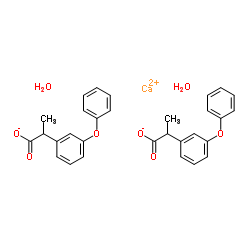Influence of rheumatoid arthritis in the enantioselective disposition of fenoprofen.
Giuliano Rodrigo Barissa, Josiane Cristófani Poggi, Eduardo Antônio Donadi, Marina Lemos Dos Reis, Vera Lucia Lanchote
文献索引:Chirality 16(9) , 602-8, (2004)
全文:HTML全文
摘要
To investigate the influence of rheumatoid arthritis on the stereoselective disposition of fenoprofen administered as a racemic mixture, eight patients with rheumatoid arthritis receiving calcium rac-fenoprofen (200 mg/8 h) and 7 healthy volunteers given single oral dose (600 mg) were investigated. Serial blood samples and urine were collected from zero to 24 h after fenoprofen (FEN) administration. The following differences were observed between the (+)-(S) and (-)-(R)-FEN in the patients with rheumatoid arthritis (means 95% CI, Wilcoxon test, P < 0.05): C(max) 14.1 (12.5-15.8) versus 3.6 (2.5-4.7) microg/ml; AUC(ss) (0-8) 80.5 (67.3-93.7) versus 12.1 (8.8-15.4) microg.h/ml; Cl(T)/f 1.3 (1.0-1.5) versus 9.1 (6.5-11.8) l/h; and t(1/2) 3.1 (2.3-3.9) versus 1.2 (0.8-1.6) h. The Cl(T)/f of (-)-(R)-FEN was reduced in patients with rheumatoid arthritis when compared to healthy volunteers: 9.1 (6.5-11.8) versus 17.4 (13.9-20.9) l/h; P < 0.05 Mann-Whitney test. The administration of rac-FEN as a single dose to healthy volunteers or multiple doses to patients with rheumatoid arthritis resulted in lower Cl(T)/f for the (+)-(S)-FEN. The lower Cl(T)/f of (-)-(R)-FEN observed for patients with rheumatoid arthritis is consistent with lower clearance by inversion, although other metabolic pathways, drug interactions, and bioavailability of the individual enantiomers may also contribute to the difference.(c) 2004 Wiley-Liss, Inc.
相关化合物
| 结构式 | 名称/CAS号 | 分子式 | 全部文献 |
|---|---|---|---|
 |
非诺洛芬钙二水合物
CAS:53746-45-5 |
C30H30CaO8 |
|
Rapid simultaneous determination of four non-steroidal anti-...
2010-08-01 [Appl. Spectrosc. 64(8) , 949-55, (2010)] |
|
Single dose oral fenoprofen for acute postoperative pain in ...
2011-01-01 [Cochrane Database Syst. Rev. (2) , CD007556, (2011)] |
|
Synthesis of dehydroabietic acid-modified chitosan and its d...
2009-01-05 [Carbohydr. Res. 344(1) , 9-13, (2009)] |
|
Hyphenation of ionic liquid albumin glassy carbon biosensor ...
2013-04-15 [Anal. Chim. Acta 772 , 68-74, (2013)] |
|
Synthesis and in vitro antitumor effect of diclofenac and fe...
2007-01-01 [Eur. J. Med. Chem. 42(1) , 20-9, (2007)] |